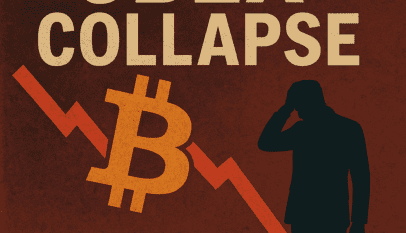CBEX, once the darling of online investor forums, now stands accused of misleading thousands and vanishing with millions in user funds. This investigation by Deborah Nnamdi traces the platform’s rapid rise, its suspicious unravelling, and the lingering questions left in the wake of its humpty-dumptyish collapse.
In the rapidly evolving world of digital finance, few stories have stirred as much frustration and confusion as the collapse of Crypto Blockchain Exchange (CBEX). Once hailed as a promising, AI-powered crypto investment platform with global ambitions, CBEX is now a sobering reminder of what happens when hype outruns accountability.
CBEX burst onto the scene with bold claims. It promised high-yield investments through AI-driven trading algorithms, decentralised finance (DeFi) tools, and staking protocols. Its sleek user interface, futuristic branding, and aggressive marketing campaigns drew in thousands of eager investors from Asia, Europe, and Africa. But beneath the surface, a troubling pattern of dysfunction and deception quietly unfolded.
The Rise of CBEX: All Shine, No Substance?
CBEX positioned itself as a revolutionary platform blending algorithmic trading with tokenised assets. It painted a vision of seamless, decentralised investing with stable returns and minimal risk. For investors hungry to ride the crypto wave, the platform seemed like a golden opportunity.
What helped CBEX gain early traction was a combination of strategic influencer partnerships, flashy webinars, and an assertive referral program. Its supposed CEO, Leo Zhang, was portrayed as a seasoned crypto visionary—though little verifiable information ever surfaced about him.
Yet, even as CBEX gained momentum, cracks began to show.
The Warning Signs Emerge
Trouble began with something no investor wants to hear: withdrawal delays. CBEX cited “technical upgrades” and “routine maintenance,” but these explanations soon wore thin as the delays stretched from days into weeks.
Communication deteriorated. Company announcements became sporadic and increasingly vague. Telegram channels that were once buzzing with moderator updates fell silent. Users were met with dashboard glitches, fluctuating token values unlinked to market trends, and, in some cases, disappearing account balances.
Attempts to verify the platform’s legitimacy hit dead ends. The company’s business registration details were murky at best, and there was no clear regulatory oversight. What had once looked like a next-gen crypto investment platform started to resemble a digital mirage.
Timeline of Collapse
- August 2022: CBEX launches publicly, boasting over 20,000 signups in its first two weeks. Early investors receive deposit bonuses and referral perks.
- November 2022: The “AI Smart Pool” is introduced, claiming to use machine learning to trade across multiple crypto exchanges with minimised risk.
- January 2023: Linda Mwangi, a marketing consultant in Nairobi, invests $8,500 after a friend claims to have doubled his money. “It looked professional. I even joined a Zoom call with their team,” she recalls.
- March 2023: Withdrawal issues begin. CBEX blames wallet maintenance and growing user demand.
- June 2023: Investor forums erupt with complaints. Frozen funds, syncing issues, and erratic dashboard behaviour are widely reported.
- August 2023: South African tech blogger Chris Dlamini publishes a scathing exposé, pointing out inconsistencies in CBEX’s blockchain activity and its dubious offshore incorporation in the British Virgin Islands.
- October 2023: CBEX disables live customer support. Community moderators go silent. Prominent local promoters vanish.
- January 2024: CBEX announces it is entering “hibernation mode” to restructure. Thousands of investors lose access to their funds.
- March 2024: A collective called CBEX Victims United is formed, amassing over 4,500 members across 18 countries. One of them, Martin Hsu, a teacher in Singapore, says he lost nearly $20,000 in retirement savings.
Behind the Curtain: A Familiar Playbook
What CBEX promised—high, steady returns backed by proprietary technology—was enticing. But a closer inspection reveals it followed a well-worn script common to many modern Ponzi schemes.
Leo Zhang, the so-called CEO, had no verified LinkedIn profile, no public speaking appearances, and even used stock images in company bios. The much-hyped trading algorithm was never independently audited. Payouts and withdrawals were routed through anonymous crypto wallets, making tracing funds nearly impossible.
With no clear regulatory body overseeing operations, CBEX was free to operate in a legal grey area—until it collapsed under its weight.
Echoes of the Past: CBEX Is Not Alone
CBEX’s structure and tactics closely resemble notorious financial scams dressed in different digital clothing.
- MMM (Mavrodi Mondial Moneybox): A global Ponzi scheme founded by Sergei Mavrodi. Promised 30% monthly returns through a P2P donation model. It collapsed in 2016, wiping out billions in savings.
- Crowd Rising: Marketed as a humanitarian crowdfunding system, it relied heavily on recruitment. Thousands, especially in West Africa and Southeast Asia, lost funds when it abruptly disappeared.
- Helping Hands International (HHI): Disguised as a charitable initiative, HHI used a matrix structure and offered extravagant incentives like cars and electronics. It crumbled once new signups stopped.
CBEX followed a similar formula: high returns with vague justifications, referral-heavy growth models, charismatic yet unverifiable leadership, crypto-based transactions to avoid regulation, and sudden shutdowns blamed on technical or legal hurdles.
The Psychological Toll
The financial loss is devastating, but so too is the emotional impact. Victims often speak of feelings of shame, betrayal, and deep regret. Many were persuaded not just by profits, but by the belief that they were part of something innovative and transformative. This sense of belonging—cultivated through slick branding, webinars, and community chats—only deepens the sense of personal violation when the truth emerges.
Rachel K. from Ghana, who lost her family’s savings in CBEX, said, “We were told this was the future. Now, I feel like I was tricked into betraying my own family’s trust.”
A Digital Mirage
The CBEX story is not an isolated one—it’s a symptom of a larger problem. As digital finance tools become more advanced and harder to regulate, bad actors are finding new ways to exploit investor optimism. From blockchain to DeFi, the terminology may change, but the fundamental tactics remain the same.
Today’s scammers don’t need physical offices or fake paper trails. They only need a good website, some buzzwords, and a few paid influencers to generate enough momentum. Once the money starts flowing in, the house of cards builds quickly—and falls even faster.
Lessons for the Future
CBEX’s implosion highlights the urgent need for greater investor education, stronger cross-border regulation, and more scepticism in the face of too-good-to-be-true offers. Platforms promising massive returns with minimal risk, discouraging scrutiny, and relying on constant recruitment should be treated with extreme caution.
For the thousands caught in the CBEX collapse, the road ahead is uncertain. Legal redress is likely to be slow, if it comes at all. But the painful experience has sparked conversations, awareness campaigns, and grassroots efforts to prevent others from falling victim.
Mirage or Miracle?
The CBEX saga is a stark reminder of a timeless truth in investing: if something sounds too good to be true, it probably is. Innovation can bring incredible opportunities, but when innovation meets greed without guardrails, the result is often exploitation disguised as progress.
The next big thing in crypto might already be out there. But as CBEX has shown, not every bright idea shines for the right reasons.





































